Traces of ancestor veneration can be found in sites of the early Neolithic age. The Shang dynasty perfected this system and left behind written documents on the performance of ancestral rites in the shape of oracle bone inscriptions (jiaguwen 甲骨文). The interpretation of archaeological finds adds to the picture.
From the oracle inscriptions it can be learnt that the posthumous names of the Shang kings each of which includes a "number" of the ten celestial stems (shi tiangan 十天干, see calendar) are related to a certain day in the ten-day week (xun 旬) on which particular ancestors were presented offerings. The sacrifices for King Tai Jia 太甲 (trad. r. 1753-1721), for instance, were performed on a day with the cyclical sign jia 甲. Which number was given to an ancestor, perhaps depended from his or her day of birth, or the day of death, or according to ritual units (Chang 1980: 169-172). The distribution of "numbers" might be associated with the custom to circulate succession within the dynasty, with the rule that succession cannot stay within the same gan unit (Chang 1980: 178).
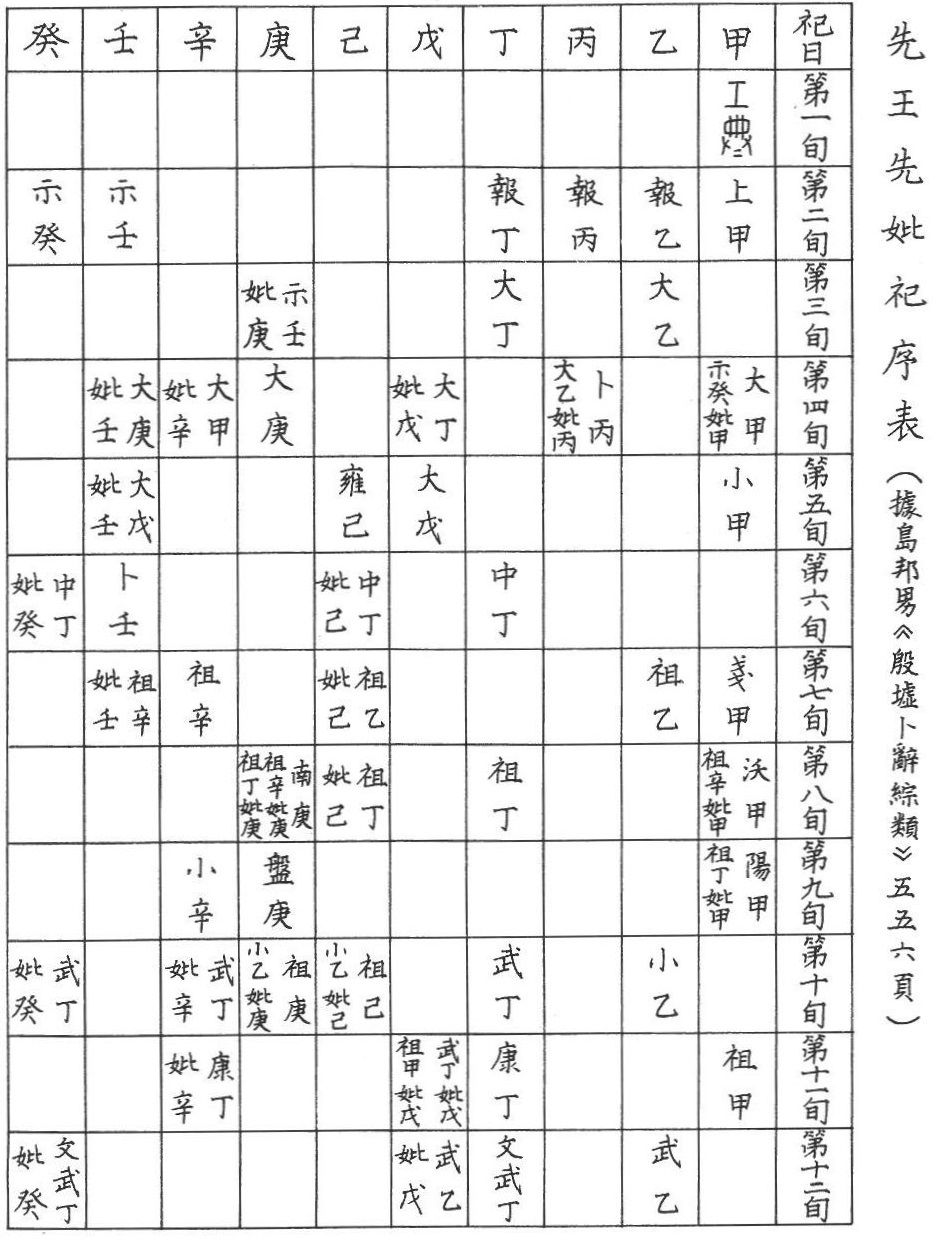 |
Table showing the distribution of gan numbers (Celestial Stems) among the kings of the Shang dynasty (along with their heir-producing consorts, bi 妣) and their relation with regular sacrifices over a period of twelve ten-day weeks (xun 旬). The busiest day was the seventh day of the eighth ten-day week on which sacrifices were delivered to Nan Geng 南庚 (trad. r. 1433-1409), Zu Xin 祖辛 (trad. r. 1506-1491) and his consort Bi Geng 妣庚 (1), and Zu Ding 祖丁 (trad. r. 1465-1434) and his consort Bi Geng 妣庚 (2).
After Yao and Xiao (1989), Vol. 2, 1474, based on Shima Kunio 島邦男 (1971). Inkyo bokuji sōrui 殷墟卜辭綜類 (Tōkyō: Kyūko Shoin). |
The most powerful spirit of the Shang people was the supreme ancestor of the dynasty, Di 帝 or Shangdi 上帝. The real meaning of this term remains unknown. The Supreme Ancestor was able to bring good and disaster upon the reigning dynasty and thus perhaps exerted control over natural powers like winds, rain, drought, earthquakes, sun and moon, moutains, rivers, etc. In some respect, Di corresponded to "Heaven" (tian 天) in Zhou religion, yet without the concept of a "mandate" which Heaven had bestowed (tianming 天命) on the Zhou dynasty 周 (11th cent.-221 BCE).
The descendants of the Supreme Ancestor were venerated as well, and the oracle bone inscriptions mention most of the Shang kings whose names are transmitted in traditional sources like the universal history Shiji 史記. Royal consorts (bi 妣) were likewise venerated as ancestral spirits.
While the Supreme Ancestor was not accessible to the mediums (wu 巫, "shamans" or "sorceres") or the Shang king, the latter's more direct (historical) ancestors were. The ancestors communicated with the king not just by the cracks in oracle bones (bu 卜), but also in dreams and maladies. The more remote ancestors were more powerful than younger ones ("generationalism", Thorp 2006: 184; "generational hierarchy", Campbell 2018: 109), and had to be pacified by sacrifices, which were an posthumous mode of veneration of the older generation: The spirits of the death had to be fed, clothed, armed, and entertained, in order to please their divine or numinous power.
Temple compounds (zong 宗) consisted of an elevated hall (tang 堂), a courtyard (ting 庭), a gate (
All knowledge on Shang religion is either based on archaeological finds, which speak only indirectly and have to interpreted in the right way, or on oracle bone inscriptions. Both sources represent only a small aspect of Shang religion, namely the liturgical practice of the upper class or even just that of the royal house of Shang and the princely lineages. The inscriptions therefore represent the "state religion" of the Shang dynasty (Eno 2009: 41). Moreover, archaeology has demonstrated that "China" was not ruled by a series of dynasties, as traditional historiography holds, but the Shang were only one of many political and cultural realms, many of which might have had beliefs and religious customs differing from that of the Shang.
There were five types of rites, namely rong rites 肜, accompanied with drums, yi rites 翌, accompanied by a "feather dance", ji rites 祭, during which meat dishes were offered to the ancestors, huan or zai (?) rites {(才/隹)*丸}, which included the offering of grain meals, and xie rites {劦/口}, which required various meals. During all types of sacrifices, wine was presented to the ancestors. The Republican period scholar Dong Zuobin 董作賓 (1895–1963) has shown up the complex rules according to which these five types of sacrifices were performed in the course of the year (Li 1977: 249-251). The rules for these ancestral offerings took a strict shape during the reign of King Zu Jia 祖甲 (trad. r. 1258-1226).
Music during the offerings was accompanied by drums, sound stones, and perhaps bells, pipes or similar aerophones. Wine and eatables were served in different ways. After being presented in bronze or earthen vessels, some were poured out into sacrificial pits, others burnt (liao 燃) and buried in sacrificial pits, yet others suffocated in water (chen 沉), and sometimes sacrificial animals were buried alive (mai 埋).
The number of sacrificial animals (xisheng 犧牲, sheng 牲) was considerable. The offerings to the pre-dynastic (xianwang 先王) ancestor King Hai 王亥 (quite strangely, hai 亥 is not a celestial stem, but one of the Twelve Terrestrial Branches, shi'er dizhi 十二地支), who is in transmitted historiographical sources called Zhen 振, and who was the father of Shang Jia 上甲, required as much as 300 oxen (Li 1977: 254), at least during the early and middle Shang period.
Ritual bronze vessels can be categorized in such for storing beverages (hu 壺, pou 瓿, you 卣, lei 罍, fou 缶), pouring beverages (gong 觥, he 盉), heating or drinking liquids (jia 斝, jue 爵, gu 觚), cooking meat (ding 鼎, li 鬲, yan 甗), presenting meat (gui 簋/𣪕), consuming meat (dou 豆, yu 盂), storing water (fou, guan 罐), pouring water (gong, he, yi 匜) or collecting water (pan 盤). The diversity of vessels shows how sophisticated ritual meals or offerings were.
Human offerings were common practice, but it can barely be known whether the victims were exclusively war captives and slaves or if their number also included subordinates of the elite. Chinese scholars discern human sacrifice (renji 人祭 or rensheng 人牲 "men as sacrificial animals"), used to placate natural deities or ancestors, from persons killed to accompany the lord to serve his spirit in the netherworld (renxun 人殉). From the Erlitou period 二里頭 on (2000-1500 BCE), sacrificial pits contained the remains of pigs, oxen, human skulls and chopped human skeletons (Wang 1994: 144). These types of sacrificial pits were found around temples, but also near the foundation of secular houses. The custom of human sacrifice is also often mentioned in oracle bone inscriptions.
Some human victims were beheaded and laid down on the ramps leading down to the tomb chamber, while others were buried in special pits inside the tomb chamber, yet accompanying humans were buried in the so-called "waist pits" (yaokeng 腰坑) below the coffin of the tomb owner, others placed at the side of their lord, and had their own coffin.
The number of humans killed or slaughtered to accompany their master (male and female) into the neither world depended on the status of the tomb owner. While human sacrifice was seen as early as the Erligang period 二里崗 (1600-1400 BCE), the Anyang period 安陽 (1250-1050 BCE) was the apogee of this bloody custom. In the tombs of Anyang, more than 3,000 human victims were discovered, while the numbers mentioned in oracle bone inscriptions sum up to more than 10,000 (Wang 1994: 143, 150). The number of persons (servants, guardians, charioteers, concubines) accompanying their master into death was as large as 400 in royal tombs (Wang 1994: 154).
The bloody burial rites of the Shang interestingly left no trace in the memory of the historiography of the succeeding Zhou dynasty. In the Zhou moralist's eyes, the last depraved rulers of the Shang have been lustful, not bloody. Reason for this might be that in the early Zhou phase, human sacrifices were also part of Zhou burial rites, but those were abandoned later, and humans were replaced by wooden or pottery figurines.
Because of the missing of hints on such bloody rituals, archaeologists were horrified when they excavated the royal tombs of Anyang in the 1930s. Yet knowledge of the custom of laying accompanying persons in tombs was still present in the Warring States period 戰國 (5th cent.-221 BCE). The book Mozi 墨子 (ch. Jiezang 節葬) speaks of several hundred victims for a king.
Tombs of the Shang kings and high dignitaries were richly furnished with ritual vessels of bronze, earthenware or lacquerware, weapons, objects of various stones, bone, jade or ivory, and even chariots along with horses and charioteers (see Shang military). Most tombs were looted over time, but in Anyang, the tomb of queen Fu Hao 婦好 was untouched and therefore revealed the wealth of the Shang court. It included 195 bronze vessels, 271 weapons and tools, 755 pieces of jade and 110 objects made of other stones, 564 objects made of bone (Bagley 1999:194-195).
Many objects demonstrate how widespread the network of trade and diplomacy was during that time: copper, tin and lead for the bronze items from far-away provinces, jades probably hailing from Hetian 和田 (Khotan) in Xinjiang, and cowries from the Indian Ocean that came to China across Yunnan.
Local sacrifices (sheji 社祭) outside the central temples were carried out by using a large stone as an altar, as can be seen in the site of Qiuwan 丘灣 near Tongshan 銅山, Jiangsu. Certain types of trees were also included in sacrificial ceremonies, and symbolized natural powers. A sentence in the Classic Lunyu 論語 "Confucian Analects" (ch. Ba yi 八佾) holds that the "holy tree" of the Xia dynasty 夏 (21th-17th cent. BCE) was the pine (song 松), that of the Shang the cypress (bai 柏), and that of the Zhou dynasty a chestnut (li 栗).
The most important part of the Shang pantheon are dynastic ancestors with certain powers. The number of ancestors includes direct ancestors of the royal lineage (dynastic and pre-dynastic), together with heir-producing consorts, as well as human spirits outside the lineage core, so-called "former lords" (xiangong 先公) perhaps tied to the house of Shang by marriage, and natural powers. The latter included the "Supreme Ancestor" Di or Shangdi (Eno 2009: 55).
The core lineage ancestors, whose tablets stood in the ancestral shrine (zong), did not only reach back to the dynastic founder Da Yi 大乙 (Tang the Perfect 成湯), but go further back to Shang Jia. These pre-dynastic kings were particularly powerful and could influence weather and crops, while the dynastic ancestors (Da Yi and younger) could affect the king's person and outcomes in the sphere of human life (which the pre-dynastic ancestors could also do).
The princely lineages venerated different ancestors (and not no natural powers, nor the Shangdi), but apart from a quite recent find from 1991 of princely oracle inscriptions (Eno 2009: 50, 78), not much can be known about other "deities" or ancestral spirits, and nothing about the belief of the common people.
Contact between the ancestors and the human world was established by the king, who acted as a "thearch" (Eno 2009: 58) in certain rites and ceremonies.
The former lords include ministers like Yi Yin 伊尹 (who might have married a Shang princess) and persons whose relation to the royal lineage is unclear. Such "high ancestors" (gaozu, di 帝) are Kui 夔, Ku 嚳, or Wang Hai.
Among all natural powers, the personification of waters, He 河 (the Yellow River), and that of mountains, Yue 嶽 (Mt. Songshan 嵩山, see Five Sacred Mountains 五嶽), are the most important. They influenced weather and crops and could harm the king. Quite interestingly, there is no clear line dividing natural powers from ancestral "powers" of the lineage. Both types of spirits are included in the same listings in oracle bone inscriptions.
Apart from rivers and mountains, the sun occupied a prominent place in Shang cults (see offerings to sun and moon). It was eighter seen as a distinct power, or as a decisive determinator of the dates and times of certain rituals, as for instance, the individual days of the ten-day week (xun) on which particular ancestors were venerated. The myth of the ten suns, nine of which were brought down by Archer Yi 后羿, might be releated to this field of meanings. It might be that the cult of the sun was an occasion for the king to bring all lineages under his control because offerings to the sun concerned everyone, and not just the royal lineage (Eno 2009: 66-67).
Oracle bone inscriptions also mention sacrifices delivered to cardinal directions, winds and the earth.
The most powerful deity of the Shang das Di or Shangdi. Di was all-powerful and influenced all natural phenomena and personal circumstances, like political events, hunts, and the like. Some texts demonstrate that Di was even able to order events to be realized by other powers. Some scholars therefore interpret the Shang pantheon as a kind of proto-bureaucracy (Eno 2009: 71), as it is common, for instance, in the pantheon of Daoist or popular belief. Di, the supreme deity, conferred fruitful harvest and divine assistance in battle.
Di was so powerful that it was the only power not having its own cult. Apparently, the Di was so distant that the king would not be able to reach him. The identity of Di is much under discussion. Some scholars hold it was identical with Kui (Ku), others see in this power a personification of the celestial pole, while yet others interpret the word di 帝 as a generic or collective term (Eno 2009: 72-76).
Continuity from the Neolithic age wide into historical times is seen in the shape and contents of elite graves from the age of the Liangzhu Culture 良渚文化 (3400–2250 BCE) to the beginning of the imperial age in 221 BCE. Elements of this funeral practice are inner coffins (guan 棺, jiu 柩) and outer coffins (guo 槨), burial goods consisting of weapons, jade objects (including a special piece put in the dead person's mouth, han 琀), earthenware pots, ivory objects, and (from the Erlitou period on) bronze vessels. Tombs of the elite were separated from those of commoners. Vessels, both earthenware and bronze objects alike, contained food offerings.
The tomb furnishings were expressions of the prestige of the tomb owner, both in economic and political means. The meaning of weapons as tomb furnishings is still not fully understood. Weapons of jade might be part of the general belief that jade, as a very beautiful material hard to work, had the magical power to protect the corpse from decay. In early burials, the types of jade objects were considerable, ranging from animal-shaped pieces to rings, eardrops, to instruments like bi 璧 disks and square cong 琮 tubes, which might have had ritual functions.
Another material believed to preserve the corpse was cinnabar, traces of which were found in several tombs. The use of cinnabar ceased around the 5th century BCE, while that of jade increased and flourished during the Han period 漢 (206 BCE-220 CE), when princely corpses were virtually clad in nephrite armour.
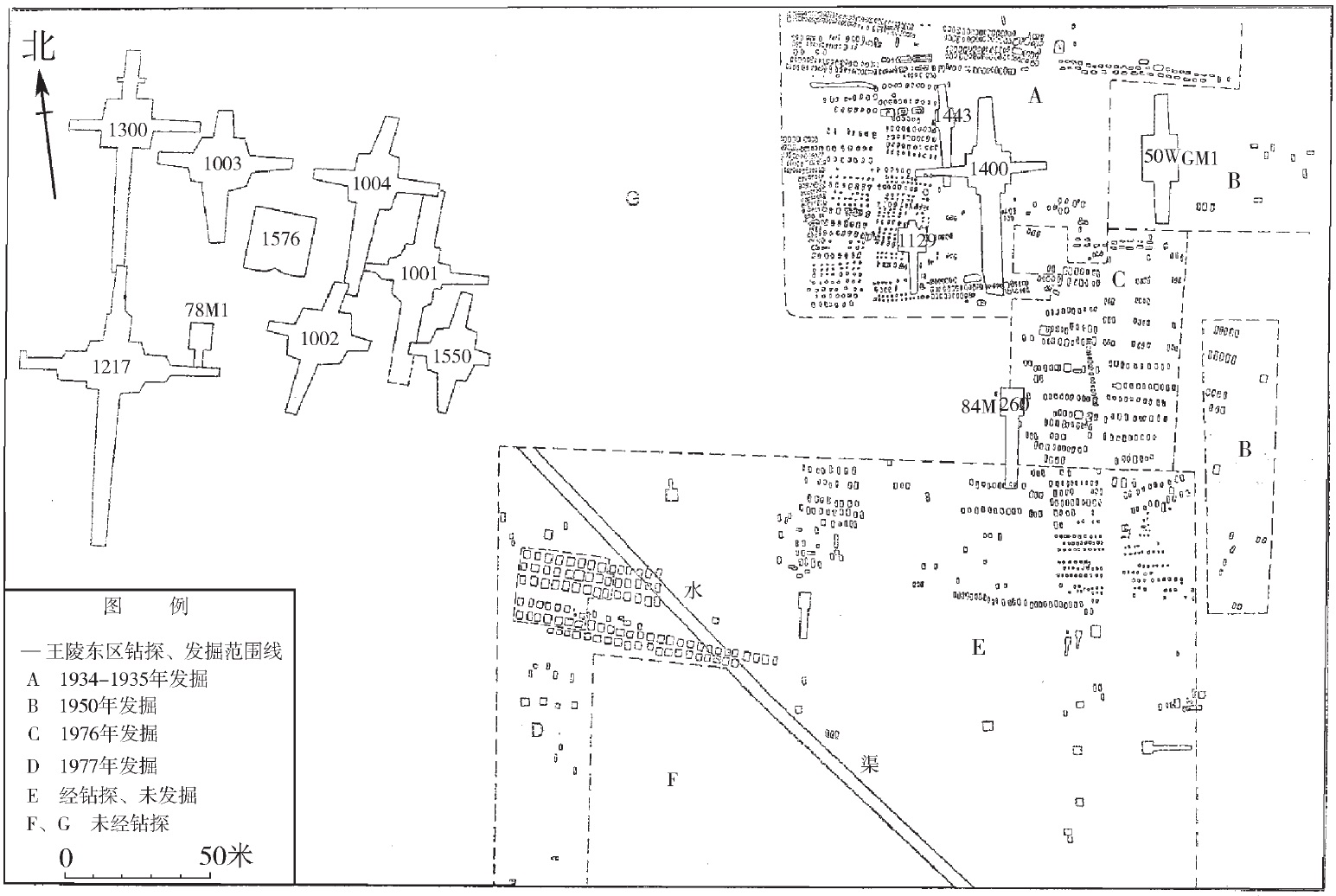 |
|
The eastern (commoners or princely lineages) and western (royal family) cemetery compounds in Xibeigang 西北崗, Anyang. The large letters refer to excavation seasons. Zhongguo Shehui Kexue Yuan Kaogu Yanjiusuo 2003: 301. |
|
Early Shang period tombs of Erligang and other sites do not show great difference between the tombs of commoners and those of the nobility. There is neither spatial separation, nor distinctions for furnishings. This changed drastically in case of the tombs of the Anyang period, when small tombs of common or low-standing persons were grouped separately and at a certain distance from the tombs of kings, consort, princes, and dignitaries.
The royal tombs are oriented north-south, with a few degrees to the northwest. Coffin and burial objects were placed in a 10m-deep rectangular shaft, and from each side, a long ramp led down to the floor, resulting in a cruciform complex with a length of more than 100m in some cases. The tomb chamber was reveted with wooden planks. Offerings were placed in the tomb chamber as well as in pits between the chamber and the earth of the shaft. The same is true for human victims, some of which were found side by side with the coffin, others around the tomb chamber, and some below the coffin in a special "waist pit" (yaokeng).
The ceiling of the tomb chamber was at level with a narrow terrace (ercengtai 二層臺). This was the place where the ramps ended. The space above the tomb chamber was filled with rammed earth in several layers. The tomb was thus sealed hermetically, so that no access was possible when the burial was finished. Remains of wooden temples or altars on the ground level right above the tomb chamber were found in some instances. More human victims were found on the ramps and around the tomb (Thote 2009: 116).
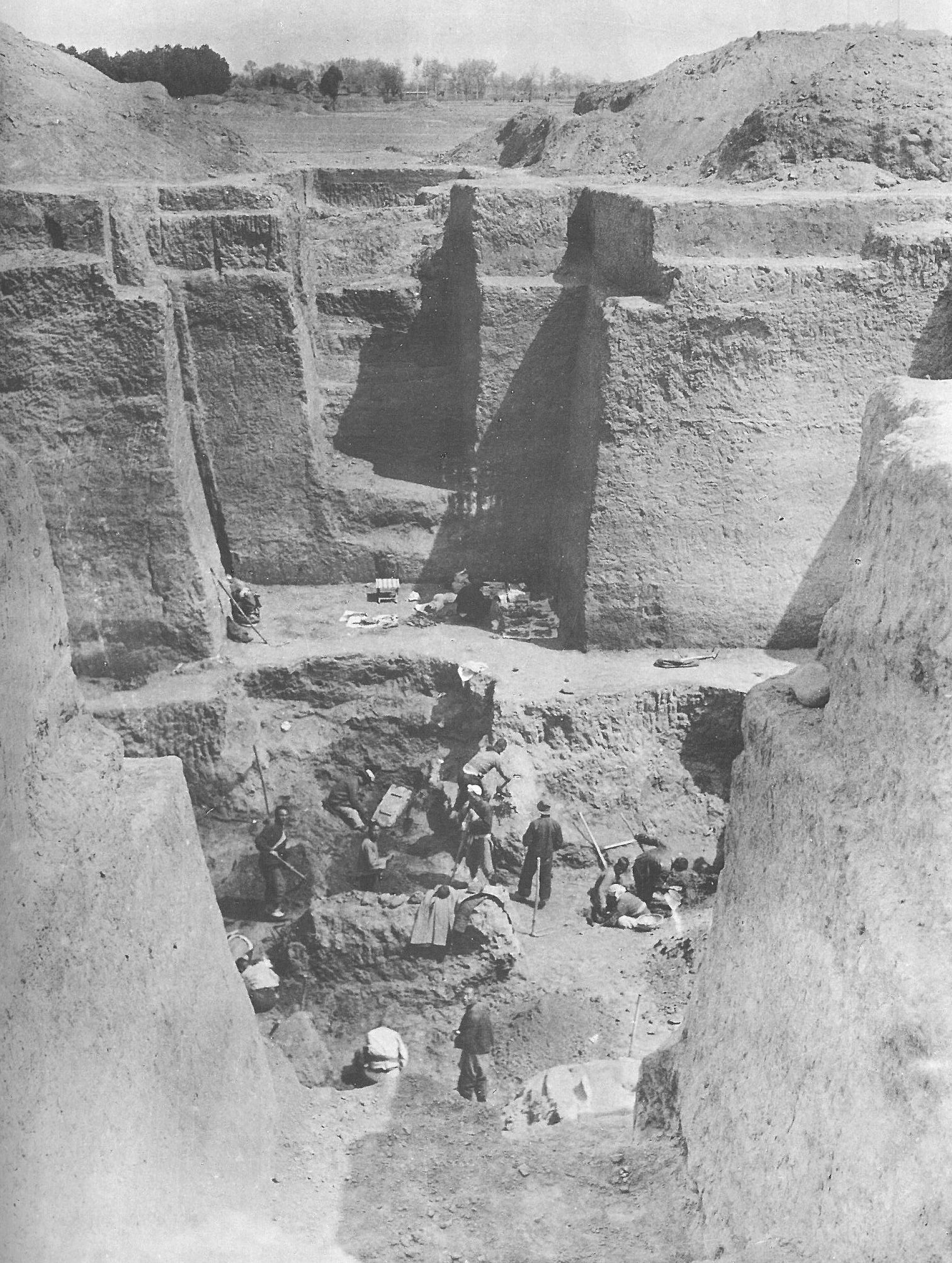 |
|
Left: Tomb shaft during excavation. The persons are standing on the bottom of the tomb chamber which was looted by grave robbers in earlier times, so precious burial objects are not preserved. From Gao (1962), Vol. 2, Plate VI. |
|
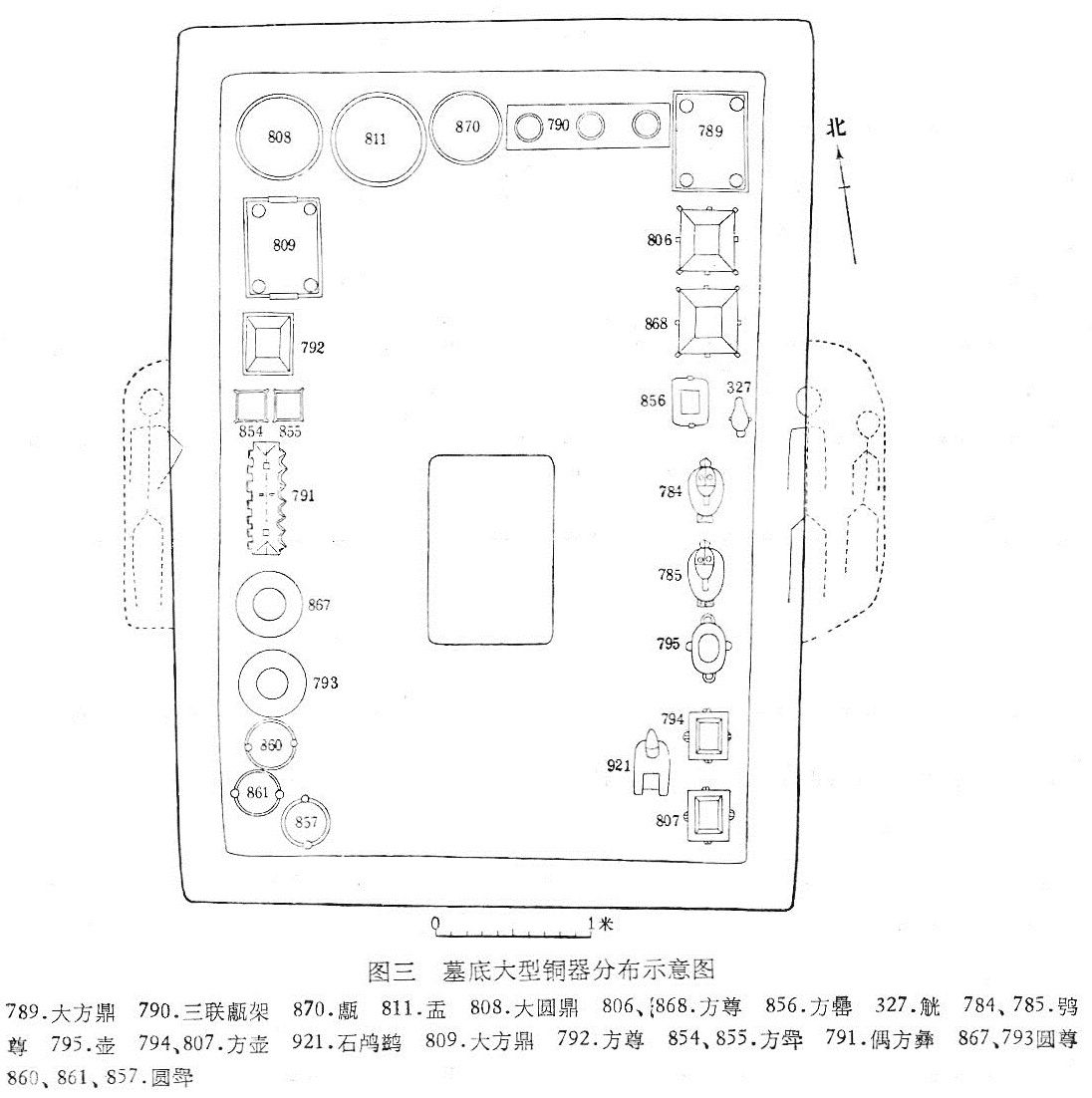 |
|
Drawing of the positions of bronze vessels used as offerings in the tomb of Queen Fu Hao. In the centre of the tomb chamber, the "waist pit" (yaokeng) can be seen, on top of which the coffin (decayed, as are the queen's remains) had been placed, and to the left and right, placed on the surrounding "second-floor terrace" (ercengtai), the skeletons of accompanying death. The number of square vessels is quite high (see Shang art). Quite outstanding are the two zun 尊 vessels in the shape of owls (xiaozun 鴞尊, nos. 784, 785), and the stand with three yan-type 甗 stewers (sanlian yanjia 三聯甗架, 791). From Zhongguo Shehui Kexue Yuan Kaogu Yanjiusuo Anyang Gongzuodui (1977). |
|
The most complete tomb was discovered in 1976. It belonged to Fu Hao, the consort of King Wu Ding 武丁 (trad. r. 1324-1266). It contained huge numbers of ritual bronzes, bronze weapons, jade amulets and other objects of nephrite, as well as numerous other items in bronze, bone, ivory, turquoise and stone, and earthenware pots. Over a hundred of the bronzes were inscribed with the Queen's name. These might have been personal belongings, while another number of vessels was probably cast particularly to serve as grave goods (Thote 2009: 112). The lavishly equipped tomb of a consort can give the impression how rich the grave goods for the much larger tombs of the Shang kings must have been. The preparation and construction of such sites must have required the organized work of several years (ibid.).
The late Shang kings carried out routine divinations according to a sacrificial schedule (Eno 2009: 83). Through divination, prayer and sacrifice the king explored the will of the ancestral spirits. The king was the channel between the deities and the world, all power emanated from this "theocrat" (Chang 1980: 202). Divination was carried out with the help of and recorded on the prepared bones of oxen (shoulderblades, scapulas) or the breastshields (plastrons) of tortoises. This type of divination is called scapulimancy or plastromancy.
Inscribed oracle bones were only found in Anyang, and not in other Shang-period sites. The inscriptions include the preface (by modern Chinese experts called xuci 序辭 or 敘辭), indicating the date and the diviner, the so-called "charge" (mingci 命辭), indicating the topic or question of the divination, often in positive and negative pairs (duizhen 對貞), the prognostication (zhanci 占辭), an interpretation of the resulting cracks, and finally the verification (yanci 驗辭), which records actual events verifying the divination. Not all these parts are necessarily included. In many cases, the same question was posed several times, and there are larger bones, on which several issues were recorded (Chang 1980: 91).
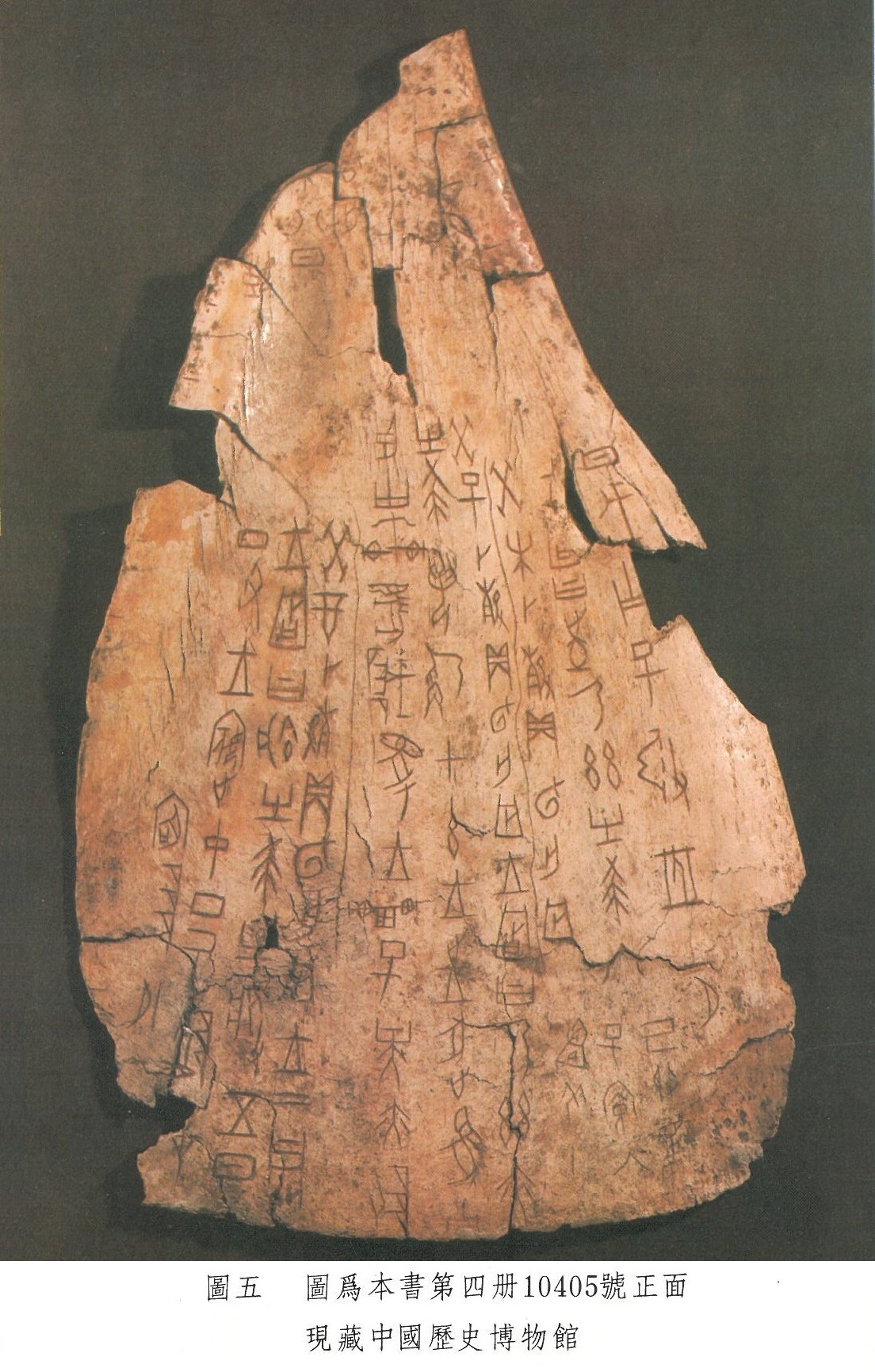 |
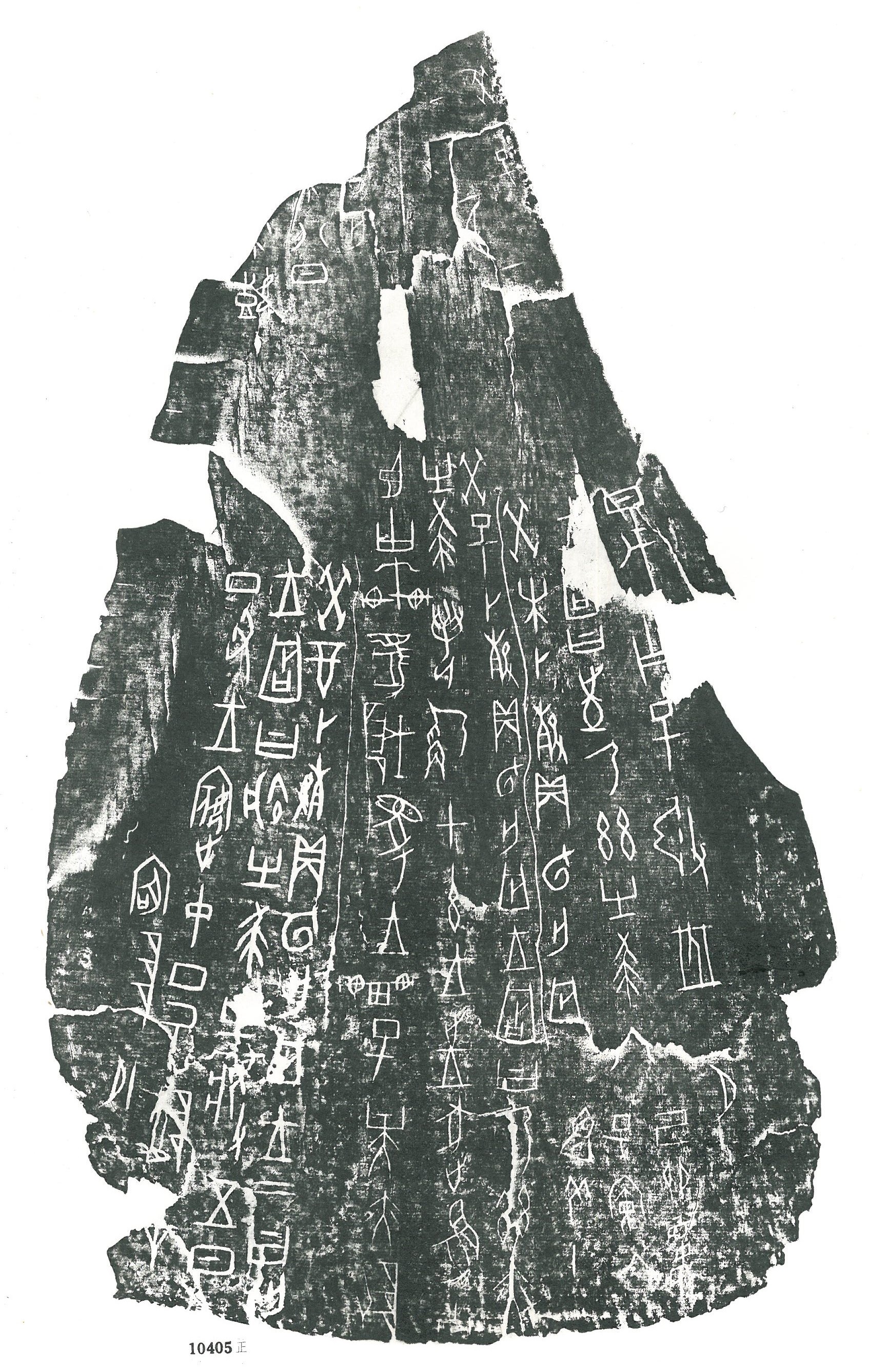 |
Oracle bone with three lengthy inscriptions, left the original, as it is exhibited in the Museum of Chinese History (Zhongguo Lishi Bowuguan 中國歷史博物館, since 2003 National Museum of China, Zhongguo Guojia Bowuguan 中國國家博物館), right a rubbing of the same piece. Size: length 32,2cm, width 19,8cm. From Guo/Zhongguo Shehui Kexue Yuan Lishi Yanjiu Suo (1982), Vol. 1, fig. 5; Vol. 4, no. 10405. |
|
The prognostication was made according to the cracks emerging when heating the surface of bones (shoulder blades or long bones of buffaloes or turtle plastrons) by applying a hot object into artificial holes. In older pieces, the cavities were round, while in later times, the diviners had oblong cavities prepared. The method of applying heat was refined in the course of time. During the early Shang period, the incision of cavities was still unknown, which led to very irregular patterns of cracks, just like in those of the Longshan Culture 龍山 (3200–1850 BCE), from which the Shang inherited the custom of divination by bones.
The inquiry included three persons, namely an inquirer (zhen 貞), a diviner (bu 卜) who produced the cracks, and a prognosticator (zhan 占) who interpreted the cracks. Archivists (shi 史) prepared the bones for storage. Divinations were made concerning sacrificial rituals, military campaigns, hunting expeditions, comings-and-goings, well-being in a future period, sickness, harvests, requests for rain or fair weather, life and death, birth, dreams and building. Many inquiries followed a fix schedule, for instance, ten-day weeks (xun).
The periodization of oracle texts, based on early research by Dong Zuobin on the names of diviners, shows changes in religious practice and the constitution of the "pantheon". Dong Zuobin identified two groups of diviners, of which the first was responsible for more or less the whole pantheon, and the second one only for the inquiry of royal ancestors. This model is not longer adhered to, but what can be attested by recent research is that over time, the range of spirits and powers was drastically reduced. The narrowing of the recipients of divinatory inquiries runs parallel with the emergence of inscriptions on ritual bronze vessels cast for individuals other than the king.
Signs of proto-forms of divination with the help of trigrams or hexagrams (see Yijing "Book of Changes") are found in bronze and oracle inscriptions (Eno 2009: 90).
Mediums (wu 巫, "shamans", "sorcerers") were either acting on behalf of the king, or the king himself took over the function of medium, as seems to have been the case in the later Shang period. In shamanic rituals, masks or decorations showing features of animalic decorations might have played an important role. Dance and music were performed to accompany sacrificial rituals. The word "dance" /k.m(r)aʔ/ 舞 and "medium" /*C.m(r)[o]/ 巫 are phonetically close (Old Chinese reconstruction according to Baxter/Sagart). In some inscriptions, the word shang 商 seems to be a term for a dance (Eno 2009: 95), and shang 商 is one of the five basic tones of the Chinese musical system - apart from meaning "trader, merchant".